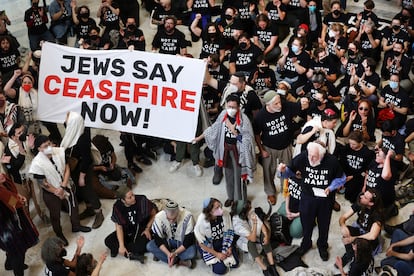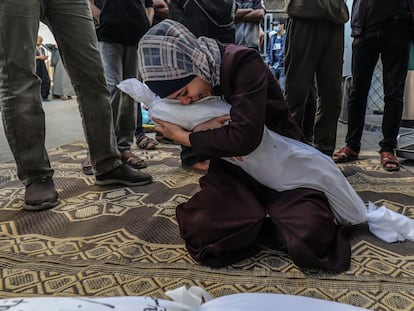The double insult of wearing the yellow Star of David
The Israeli U.N. ambassador’s decision to wear the symbol is an affront to the memory of Hitler’s and Stalin’s Jewish victims, as well as to the Palestinian population of Gaza and the occupied West Bank

The first thing that needs to be decried unequivocally at this moment are the indiscriminate bombings of the Gaza Strip by the Israeli army (IDF). One of the most densely populated places on Earth, Gaza is home to a large, already impoverished and long-suffering population, which is bearing the heaviest brunt of the Israeli attack. The civilian casualties are mounting beyond what would be expected as collateral damage in any war, let alone an assault by one of the most well-equipped armies on earth on a stateless people, forced for decades to live in enormous refugee camps.
The calls, issued by world leaders, who reaffirm Israel’s right to defend itself while respecting international law, are nothing more than half-hearted attempts by these same leaders to absolve themselves of responsibility and complicity in genocidal behavior. After all, Israeli self-defense would have amounted to efforts to protect the Israeli civilian population, living at the frontier with Gaza, at the time of the attack by Hamas militants. The tremendous failure by the state of Israel to do so on October 7 now gives way to pure and simple revenge, exerted largely against Gaza’s defenseless civilians, many of them children.
Equally prevaricating are appeals to deliver humanitarian aid without halting the bombardment of the Gaza Strip. The late Italian philosopher Danilo Zolo gave such a strategy an apt name: humanitarian terrorism. The obscene cycle of destruction-rebuilding, fed by “humanitarian assistance,” becomes the new economic logic of warfare, a global war economy with a strong component of goods and services apparently ameliorating but in fact enabling devastation. Rather than bombs dropping together with humanitarian aid, what is urgently required is a complete and immediate ceasefire, followed by a genuine peace process.
At the ideological level, the countless confusions that have been spawned to cover up the actions of the Israeli far-right neo-fascist regime cannot go unaddressed, either. Indeed, the October 7 massacre of peaceful music festival-goers and residents of kibbutz communities adjacent to Gaza must be denounced in the strongest terms possible. It is also understandable that, in light of the historic experience of the Shoah, or the Holocaust, preceded by centuries of pogroms and other types of violence against Jewish people, such events trigger a sense of collective trauma. What is inadmissible is that this trauma would be converted into a tool for traumatizing another people on a massive scale. And yet, this is precisely what is happening in the bombings of Gaza, not to mention in the decades of occupation, dispossession, displacement and physical killings of the Palestinian people by the Israeli state and by extreme groups of settlers who take the law into their own hands.
Being blind to everything except one’s own trauma — and above all being blind to the ongoing traumatization of the other through the acting out of one’s trauma — is an apt description of the Israeli body politic. It is from this condition that utterly ridiculous comparisons emerge, for instance, of Hamas with the Nazis by the former prime minister of Israel Naftali Bennett. Nazi Germany was a highly organized totalitarian state machine, which implemented its genocidal designs against (and rendered stateless) Jewish people, as well as Roma people, homosexuals, people with disabilities, and others. On the contrary, Palestinians are living in a limbo state without a regular army, under a 16-year-long blockade in Gaza and under ongoing occupation in the West Bank. If anything, the comparison, strained as it is, would have to be reversed. At the same time, the current Israeli Prime Minister Benjamin Netanyahu equates Hamas to ISIS, ignoring, among other things, the difference between a national movement of resistance to occupation and an international terrorist organization, which mixes imperial ambitions with a nihilist death cult.
The disparity between the characterizations of Hamas by Netanyahu and Bennett may be understood in light of their efforts to associate Hamas with ‘pure evil.’ Although the massacre that the group’s members perpetrated in Israel is unjustifiable, the use of moral categories, such as “good” and “evil,” serves to depoliticize the issue, to hide from view the history and the context, in which these deplorable acts unfolded. And it is but one step from the ‘pure evil’ of Hamas to a collective dehumanization of Palestinians as “human animals” by the Israeli Defense Minister Yoav Gallant in his announcement of the complete siege of Gaza. The resulting atrocities committed against a civilian population are then diluted on the grounds of the refusal to grant a human status to the victims of the siege, bombings, and expulsions. (On the other hand, as a moral term, evil is only applicable to human beings, seeing that no other animal is capable of acting based on evil intent. Paradoxically, it is a term of humanization, even though in practice it is often used to the opposite effect.)
In turn, the Israeli army’s order to Gazans to move to the southern portion of the Gaza Strip creates an extreme plight of refugees within a refugee condition: the displacement and immiseration of the already displaced population. Since no portion of the Gaza Strip is safe from bombings and since living conditions are thus rendered impossible, the order is a ploy that makes sense in the context of the “concept proposal” drafted by the Israeli government to transfer Gaza’s 2.3 million inhabitants to Egypt’s Sinai Peninsula. The “transfer” of Palestinian people from Gaza and the occupied West Bank has long been the dream of the Israeli far-right, undeterred by the ethnic cleaning and genocidal overtones of such a move. Historically, parts of the proposal were realized in the Israeli War of Independence, known as the Catastrophe, or Nakba, in Palestine. That is why Netanyahu’s statements to the effect that the current assault on Gaza is “a second war of independence” cannot help but stir in the minds of Palestinians the painful memories of 1948.
European Jews themselves were subject to master plans of mass population transfer, which both Hitler and Stalin had devised at various points in time before and after World War II. Prior to adopting the genocidal Final Solution, the Nazi leader looked for ways to remove Jewish people from German territory. Among other measures, in 1933, the Zionist movement reached an agreement (known in Hebrew as ha’avara) with Nazi Germany to transfer 50,000 Jews to Palestine. In 1940, Stalin deported over 200,000 Polish Jews from the part of Poland occupied by the Soviet Union to the gulags in Siberia. Only the Soviet dictator’s death spared Jews from Moscow and other central regions from the same fate. Nevertheless, today’s transfer proposals are prepared in Israel with regard to Palestinians, who structurally occupy the position of European Jews from nearly a century ago. That is why the yellow Star of David donned by the Israeli envoy to the U.N. and his team is a double insult to the memory of Hitler’s and Stalin’s Jewish victims, as well as to the Palestinian population of Gaza and the occupied West Bank. The true historical parallel, demonstrating the absurdity of such a gesture, would be with Stalin’s Foreign Minister, Vyacheslav Molotov (whose name has been lent to the Molotov-Ribbentrop pact) wearing a yellow Star of David at a meeting of the Politburo.
While anti-Semitic sentiments are rising worldwide, this tendency does not justify the ascription of a victim position to Israel. In part, growing anti-Semitism is a result of an active ideological program tying together Zionism and Jewish identity. Because Israeli authorities claim that they represent not only all Israelis (which is far from the truth, especially given recent mass protests against the proposed legal coup) but also all of world Jews, wrath against the state’s apartheid-style, if not genocidal, policies is directed toward Jewish people outside Israel. Nevertheless, if anything became exceptionally clear in the course of the three-week-old war, it is how deep the split between the Jews of the diaspora and those supporting the Israeli authorities is. Jewish sit-ins at the entrances to the White House or at New York’s Grand Central Station are a case in point of the refusal to be complicit in Israeli policymaking.
In addition to mass protests by American Jews against the Israeli bombardments and siege of Gaza, another hopeful moment was the release of a few of the Hamas hostages, including the 85-year-old Yocheved Lifshitz. Set free late on Monday, October 23, she turned to one of her captors. Lifschitz could not see his face, which was covered with a black balaclava. She extended her hand to the man, whose own hand was clasping a gun, shook it and uttered “Shalom,” Hebrew for peace. This literally disarming gesture, powerful in its powerlessness, points the way forward: breaking the cycles of traumatization and violence, forgiving the unforgivable, extending the hand to those deemed to be enemies, and working out the details of coexistence, sharing a small piece of land in the Eastern Mediterranean, which is rapidly becoming uninhabitable independently of wars, due to the effects of catastrophic climate change.
Michael Marder (Moscow, 1980) is a philosopher and research professor at the Basque Foundation for Science (Ikerbasque) and the University of the Basque Country.
Sign up for our weekly newsletter to get more English-language news coverage from EL PAÍS USA Edition
Tu suscripción se está usando en otro dispositivo
¿Quieres añadir otro usuario a tu suscripción?
Si continúas leyendo en este dispositivo, no se podrá leer en el otro.
FlechaTu suscripción se está usando en otro dispositivo y solo puedes acceder a EL PAÍS desde un dispositivo a la vez.
Si quieres compartir tu cuenta, cambia tu suscripción a la modalidad Premium, así podrás añadir otro usuario. Cada uno accederá con su propia cuenta de email, lo que os permitirá personalizar vuestra experiencia en EL PAÍS.
¿Tienes una suscripción de empresa? Accede aquí para contratar más cuentas.
En el caso de no saber quién está usando tu cuenta, te recomendamos cambiar tu contraseña aquí.
Si decides continuar compartiendo tu cuenta, este mensaje se mostrará en tu dispositivo y en el de la otra persona que está usando tu cuenta de forma indefinida, afectando a tu experiencia de lectura. Puedes consultar aquí los términos y condiciones de la suscripción digital.
More information
Archived In
Últimas noticias
Most viewed
- Sinaloa Cartel war is taking its toll on Los Chapitos
- Oona Chaplin: ‘I told James Cameron that I was living in a treehouse and starting a permaculture project with a friend’
- Reinhard Genzel, Nobel laureate in physics: ‘One-minute videos will never give you the truth’
- Why the price of coffee has skyrocketed: from Brazilian plantations to specialty coffee houses
- Silver prices are going crazy: This is what’s fueling the rally









































